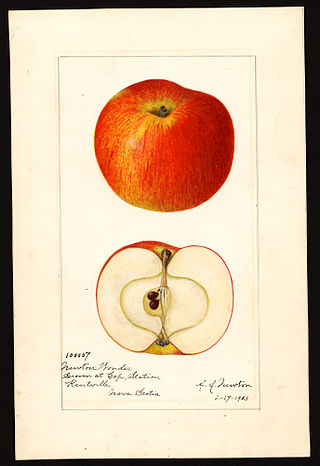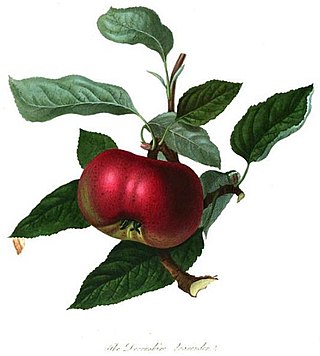
Cider apples are a group of apple cultivars grown for their use in the production of cider. Cider apples are distinguished from "cookers" and "eaters", or dessert apples, by their bitterness or dryness of flavour, qualities which make the fruit unpalatable but can be useful in cidermaking. Some apples are considered to occupy more than one category.

Malus domestica is an English cultivar of apple that is usually eaten cooked due to its sourness. The variety comes from a pip planted by Mary Ann Brailsford. The Concise Household Encyclopedia states, "Some people eat this apple raw in order to cleanse the palate, but Bramley's seedling is essentially the fruit for tart, pie, or dumpling." Once cooked, however, it has a lighter flavour. A peculiarity of the variety is that when cooked it becomes golden and fluffy.

The damson or damson plum, also archaically called the "damascene", is an edible drupaceous fruit, a subspecies of the plum tree. Varieties of insititia are found across Europe, but the name damson is derived from and most commonly applied to forms that are native to Great Britain. Damsons are relatively small ovoid plum-like fruit with a distinctive, somewhat astringent taste, and are widely used for culinary purposes, particularly in fruit preserves and jams.

A cooking apple or culinary apple is an apple that is used primarily for cooking, as opposed to a dessert apple, which is eaten raw. Cooking apples are generally larger, and can be tarter than dessert varieties. Some varieties have a firm flesh that does not break down much when cooked. Culinary varieties with a high acid content produce froth when cooked, which is desirable for some recipes. Britain grows a large range of apples specifically for cooking. Worldwide, dual-purpose varieties are more widely grown.

Gravenstein is a triploid apple cultivar that originated in the 17th century or earlier. The fruit has a tart flavor, and it is heavily used as a cooking apple, especially for apple sauce and apple cider. It does not keep well, and it is available only in season. This is in part because neither cold storage, nor regular controlled atmosphere keeps the apples' distinctive aroma, although the Nova Scotia Fruit Growers' Association states that "recently however, low oxygen CA storage has shown promise in retaining this harvest-time quality".

Gala is an apple cultivar with a sweet, mild flavour, a crisp but not hard texture, and a striped or mottled orange or reddish appearance. Originating from New Zealand in the 1930s, similar to most named apples, it is clonally propagated. In 2018, it surpassed Red Delicious as the apple cultivar with the highest production in the United States, according to the US Apple Association. It was the first time in over 50 years that any cultivar was produced more than Red Delicious.

Diospyros kaki, the Oriental persimmon, Chinese persimmon, Japanese persimmon or kaki persimmon, is the most widely cultivated species of the genus Diospyros. Although its first botanical description was not published until 1780, D. kaki cultivation in China dates back more than 2000 years.

The Santa Claus melon, sometimes known as Christmas melon or Piel de Sapo, is a variety of melon originating in Spain that grows to about a foot in length and is ovoid in shape. It has a thick, green-striped outer rind and pale green to white inner flesh with a mild melon flavour and sweetness close to honeydew melons.

The Norfolk Biffin, also spelt Norfolk Beefing, is a local apple cultivar originating from the English county of Norfolk, also known by several other names including Reeds Baker, Tallesin, and Winter Coleman.

'Discovery' is an early season dessert apple cultivar. One of its parents was the 'Worcester Pearmain', with the pollinator 'Beauty of Bath'.

'Beauty of Bath' is a dessert apple cultivar.

Malus domestica Newton Wonder is a cultivar of apple which is usually eaten cooked due to its sourness. The variety has a similar but slightly sweeter taste than the Bramley apple and is usually used in pies or as a preserve.

Bismarck is an apple cultivar. The fruit from the tree is used for cooking due to its sharp flavour and is most commonly pureed when cooking.

'Akane', also known as 'Tokyo Rose', 'Tohoku No.3' and 'Prime Red', is a Japanese cultivar of domesticated apple, that according to Orange Pippin is one of the best early season apples.

'Delbard Jubilée' or 'Delgollune' is a modern French cultivar of domesticated apple which was developed in 1964 by Delbard nurseries. It is not the same as the Jubilee apple that was developed in Canada.

Golden Russet is an old American cultivar of domesticated apple which is excellent for fresh eating as well as for apple cider production. It is a russet apple and is therefore especially used as a cider apple. It is sometimes known as 'English Golden Russet', and has frequently been confused with 'English Russet'.

Grenadier is an English cultivar of domesticated apple mainly used for cooking. It originated in the mid-19th century in Buckinghamshire. It was first recorded in 1862 in Maidstone, Kent, exhibited by Charles Turner of Slough, Berkshire, and then commercially introduced by Bunyard Nursery.

Dumelow's Seedling is a cultivar of domesticated apple that originated at Shackerstone in Leicestershire where it was grown by Richard Dumeller in 1800. It is known by many other names including 'Dumelow's Crab', 'Wellington', 'Doncklaer', 'Beauty', and 'Belle de Vennes'. The fruit is not ready for harvest until October, being one of the last of the season, and keeps well into the next year. Though inferior for use as a dessert apple it cooks well and in early-20th century England was one of the most valuable varieties of cooking apple.

The Devonshire Quarrenden is a dessert apple cultivar historically grown and probably originating in England, although it has also been suggested as originating in France. A variety of local names and spellings, including "Red Quarrenden", "Quarrington", "Quarender", and the "Sack Apple", have been recorded in the past.



















